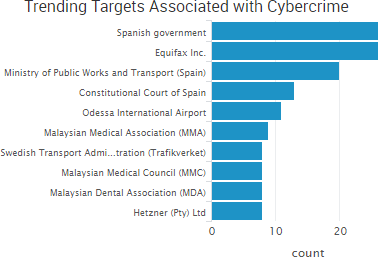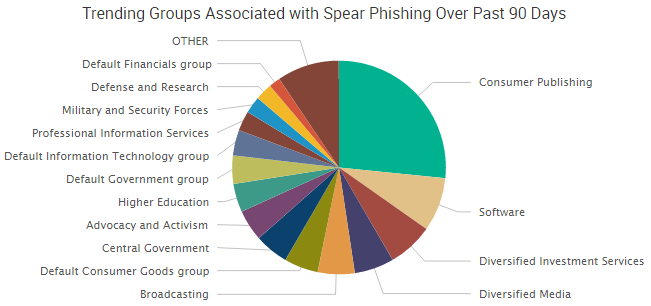The Spanish government was the week’s top trending cybercrime target due to a series of distributed denial-of-service (DDoS) and other attacks that were orchestrated by the hacktivist group Anonymous.

The Anonymous’ campaign against the Spanish government comes on the heels of Catalonia’s recent referendum on independence. As Miguel-Anxo Murado wrote in The New York Review last month, the multi-year independence movement finally came to a head in October as secessionists ignored both a ban placed on the vote by the Spanish Constitutional Court as well as the threat of police action and voted for independence.
That vote led to “mayhem,” Murado wrote, resulting in almost nine hundred people being injured throughout Catalonia as Spanish police confronted protesters and stormed polling stations in order to seize the ballot boxes. On Sunday, Reuters reported that Spain had issued arrest warrants for ex-Catalonia leader Carles Puigdemont and four associates due to rebellion and sedition charges related to the push for recession.
The independence movement has also been accompanied by what one Washington Post editorial described as “The great Catalonian cyberwar of 2017.” According to the Post, Spanish courts and authorities have in the past few months ordered telecom companies to shut down websites pertaining to the vote and forced Google Play to remove an app related to the referendum.
Scattered cyber-attacks have occurred as the issue unfolded over the past couple months; however, attacks ramped up towards the end of October as Anonymous groups on Twitter and elsewhere urged others to join the #FreeCatalonia campaign, which resulted in numerous organizations being targeted with DDoS attacks, website defacements, and other low-level malicious activity.

Other trending cybercrime events from the week include:
- Extortion attacks: TheDarkOverlord said it hacked the customer database of Hollywood production studio Line 204, and the group is threatening to leak the company’s internal client data, which includes contracts, files, invoices, and more. The group told media outlets that it will leak the data if it does not receive an unspecified ransom, a threat the group has made to numerous other hacked organizations. A malicious actor has released the personal information of 29 University of the Fraser Valley students and is threatening to release more data if the school does not pay a $30,000 ransom.
- Data leaked: Information related to 46.2 million Malaysian mobile phone numbers that was taken from Malaysian telephone companies and mobile virtual network operators in 2014 has leaked, and the data appears to have been traded among multiple malicious actors. An unnamed third party contractor for government agencies, a bank, and a utility exposed the details of 48,270 Australian employees due to a publicly accessible Amazon S3 bucket.
- Third-party-related breaches: Malicious actors used information apparently stolen in another breach to create Iowa Public Employees Retirement Systems accounts for individuals who had never created one, and they used those accounts to steal pension checks by redirecting them to different bank accounts. Kimberly-Clark is notifying a “small number” of customers that their personal information may have been compromised due to attacks that targeted registered accounts using a list of credentials leaked in other data breaches not related to the company. Midland County in Texas said a third-party payment system used to pay fines may have been compromised resulting in an undisclosed number of individuals having their payment card information stolen.
- Other data breaches: North Korean hackers were likely behind an April 2016 hack of Daewoo Shipbuilding & Marine Engineering that led to the theft of sensitive documents. Catholic Charities for the Diocese of Albany said that the personal information of clients and some employees was compromised due to hackers gaining access to a server. The certified public accountants Chiorini, Hunt & Jacobs are notifying customers that their personal information may have been compromised due to three email accounts being accessed. The Union Labor Life Insurance Company is notifying customers that their information may have been compromised when an unauthorized third-party briefly gained access to an employee’s email account and used that account to send spam messages that contained PDF documents with links to malicious sites.
- Other notable incidents: Numerous art galleries confirmed they were targeted by business email compromise scams that hijacked email communications and requested payment details be changed in order to steal amounts up to £1 million. T-Mobile said it has called all of the few hundred customers targeted by malicious actors with attempts to “swap” the victims’ SIM cards and impersonate them. An unspecified cyber attack at the Oklahoma Corporate Commission led to its network being shut down for a week. A former University of Iowa student used keyloggers to steal credentials, access 250 student and faculty accounts, and then change his grades and access his exams early.
SurfWatch Labs collected data on many different companies tied to cybercrime over the past week. Some of those “newly seen” targets, meaning they either appeared in SurfWatch Labs’ data for the first time or else reappeared after being absent for several weeks, are shown in the chart below.

Cyber Risk Trends From the Past Week
 The investigation into Russia’s alleged election-related hacking brought several new developments this past week.
The investigation into Russia’s alleged election-related hacking brought several new developments this past week.
For starters, the Wall Street Journal reported that the Justice department has identified at least six members of the Russian government connected to the Democratic National Committee (DNC) hack, and evidence is being assembled to potentially bring official charges against those individuals next year. The WSJ said that dozens of others may have played a role in the hack; however, it is possible prosecutors may wait to identify some or all of those involved until Special Counsel Robert Mueller’s ongoing investigation into alleged Russian hacking is complete.
The Mueller investigation has already resulted in several indictments as well as a guilty plea for lying to the FBI from George Papadopoulos, who served as a foreign policy advisor for the Trump campaign. The guilty plea has some overlap with the hacked emails, as court documents state that an overseas professor Papadopoulos met with multiple times “told him about the Russians possessing ‘dirt’ on then-candidate Hillary Clinton in the form of ‘thousands of emails.’”
A Sunday report from the Associated Press lays out the timeline of Russia’s hacking attempts, and that campaign appears to have begun with phishing emails sent to a list of email addresses tied to staffers of Hillary Clinton’s 2008 campaign. Most of those emails bounced back, but one of those staffers who had also joined the 2016 campaign ended up clicking on multiple phishing links — possibly providing the attackers with a fresh batch of email addresses to target. More than a dozen democrats were ultimately hacked, including John Podesta. One of Podesta’s hacked emails was the first document published by Guccifer 2.0, although it was altered. Guccifer 2.0 airbrushed the word “CONFIDENTIAL” onto the document and claimed the document came from the DNC rather than Podesta in order to entice reporters.
APT28, the group tied to the hacks, had wide-reaching targets far beyond the U.S. election, the AP reported. The group targeted the gmail accounts of 4,700 users spread across 116 countries, including Ukrainian officers, Russian opposition figures, U.S. defense contractors, and thousands of others of interest to the Kremlin. In the U.S. the targets included diplomatic and military officials; defense contractors such as Boeing, Raytheon, and Lockheed Martin, some republicans, and more than 130 democratic party workers.







